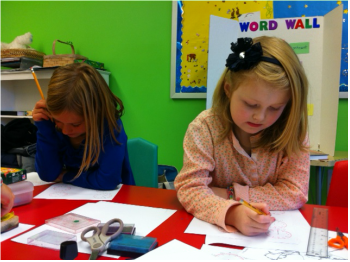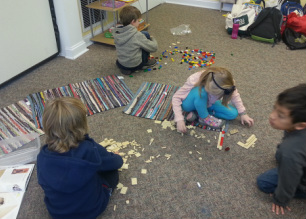Pyramid Architecture We have been continuing our exploration of Ancient Egypt the past two weeks with a look at pyramid geometry and construction. In class on 11/4, students drew and then built 3-D representations of pyramids using playdoh, paper, and legos. They learned through trial and error that to properly create their pyramid they would need a square base (not rectangular) and four equilateral (equal sided) triangles. We read about the Great Pyramid in Giza which was built for the pharaoh Cheops. See if your student can recall how many years it took workers to build the pyramid and how many three ton blocks of stone were used!
Designing a Sledge The ancient Egyptians used a simple machine called a sledge to move the heavy stones needed to build the pyramids. In our afternoon class on 11/4 we experimented with making sledges of our own.  We turned our clocks this week so we took the opportunity to talk about time telling, both ancient and modern. We went outside and tried to tell time by looking at the sun. In the classroom we learned how to read an analog clock. Letters and Sounds and Words, Oh My!
I read two of Aesop's fables to the class and we discussed the moral from each story (The Crow and The Pitcher and Belling the Cat) . I then suggested that students create their own fables by developing characters, a setting, plot, and lesson. Several students decided to take on this challenge and have made great starts to their stories. Other students opted to play language games such as Silly Sentences (creating sentences using word/phrase puzzle pieces), Story Cubes, and Spot It. In the coming weeks, we will continue our work with writing and story creation, with the goal of all students completing their own original story by the end of the semester! Making Papyrus Paper This week (11/11) we learned that the ancient Egyptians began making paper out of papyrus around the year 4000 BCE. How long ago was that? To find the answer to that question we learned about way the BCE dates count down to 0 before the Common Era years begin. Then we used the thousand cubes from the base ten set to find the answer. We made our own "papyrus" in class. Next week we will see how it turned out! Comments are closed.
|
Categories
All
Archives
May 2016
|












 RSS Feed
RSS Feed